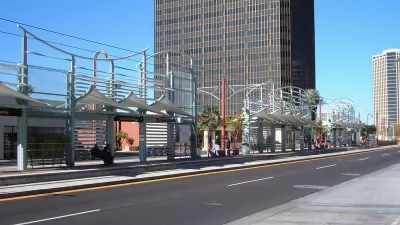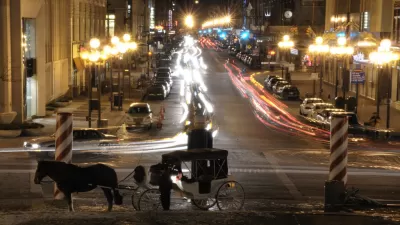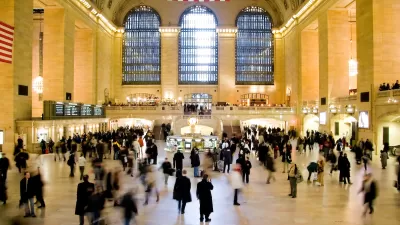Kansas City will vote today on two transportation-related initiatives. Once would inhibit the growth of the Kansas City Streetcar. Another would create a tax to find several new rail lines.
"Tuesday is Election Day for Kansas City-area cities, and voters will decide issues related to the streetcar, minimum wage and taxes," reports Lynn Horsley.
Three questions, all placed by petition initiative, will face voters today, including two that will determine the future of public transit in the city.
First: "Question 1 is from streetcar opponents, who believe streetcars are a big waste of money. This ballot measure would prohibit Kansas City municipal government from planning for or implementing any fixed rail transit system without a citywide vote of approval."
Question 2, however, "seeks a 3/8 -cent sales tax increase for 25 years to help pay the costs of a rapid rail and electric bus system." That new tax would fund:
- "A rail route from Vivion Road in the Northland to the Kansas City Zoo, with electric bus extensions beyond that to Kansas City International Airport and the Cerner campus out south."
- "Another line would go east from downtown to the Truman Sports Complex with stops at Hospital Hill, Troost, Prospect and the VA hospital."
- "Another line would go east from downtown to Old Northeast."
Horsely adds that a couple of suburban cities in the Kansas City will also consider whether or not to renew transportation and capital investment taxes.
FULL STORY: KC-area voters will weigh in Tuesday on streetcar, minimum wage, tax questions

Study: Maui’s Plan to Convert Vacation Rentals to Long-Term Housing Could Cause Nearly $1 Billion Economic Loss
The plan would reduce visitor accommodation by 25,% resulting in 1,900 jobs lost.

Placekeeping: Setting a New Precedent for City Planners
How a preservation-based approach to redevelopment and urban design can prevent displacement and honor legacy communities.

Using Old Oil and Gas Wells for Green Energy Storage
Penn State researchers have found that repurposing abandoned oil and gas wells for geothermal-assisted compressed-air energy storage can boost efficiency, reduce environmental risks, and support clean energy and job transitions.

Washington State Plans Ambitious ‘Cycle Highway’ Network
The state is directing funding to close gaps in its existing bike network and make long-distance trips more accessible.

Homeowners Blame PG&E for Delays in ADU Permits
The utility says it has dramatically reduced its backlog, but applicants say they still face months-long delays for approvals for new electrical work.

Rethinking Wildfire Defense: How a Landscape Approach Can Protect Neighborhoods
Post-fire analysis of the Eaton Fire reveals that a landscape approach — including fire-resistant vegetation, home hardening, and strategic planning — can help reduce wildfire risk, challenging assumptions that trees and plants are primary fire hazards.
Urban Design for Planners 1: Software Tools
This six-course series explores essential urban design concepts using open source software and equips planners with the tools they need to participate fully in the urban design process.
Planning for Universal Design
Learn the tools for implementing Universal Design in planning regulations.
Borough of Carlisle
Caltrans
Heyer Gruel & Associates PA
Institute for Housing and Urban Development Studies (IHS)
City of Grandview
Harvard GSD Executive Education
Salt Lake City
NYU Wagner Graduate School of Public Service
City of Cambridge, Maryland





























